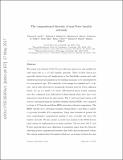| dc.contributor.author | Leith, Thomas B. | |
| dc.contributor.author | Moskovitz, Nicholas A. | |
| dc.contributor.author | Mayne, Rhiannon G. | |
| dc.contributor.author | DeMeo, Francesca E | |
| dc.contributor.author | Takir, Driss | |
| dc.contributor.author | Burt, Brian | |
| dc.contributor.author | Binzel, Richard P | |
| dc.contributor.author | Pefkou, Dimitra Anastasia | |
| dc.date.accessioned | 2020-09-16T20:33:27Z | |
| dc.date.available | 2020-09-16T20:33:27Z | |
| dc.date.issued | 2017-10 | |
| dc.date.submitted | 2017-04 | |
| dc.identifier.issn | 0019-1035 | |
| dc.identifier.uri | https://hdl.handle.net/1721.1/127640 | |
| dc.description.abstract | We present near-infrared (0.78–2.45 µm) reflectance spectra for nine middle and outer main belt (a > 2.5 AU) basaltic asteroids. Three of these objects are spectrally distinct from all classifications in the Bus-DeMeo system and could represent spectral end members in the existing taxonomy or be representatives of a new spectral type. The remainder of the sample are classified as V- or R-type. All of these asteroids are dynamically detached from the Vesta collisional family, but are too small to be intact differentiated parent bodies, implying that they originated from differentiated planetesimals which have since been destroyed or ejected from the solar system. The 1- and 2-µm band centers of all objects, determined using the Modified Gaussian Model (MGM), were compared to those of 47 Vestoids and fifteen HED meteorites of known composition. The HEDs enabled us to determine formulas relating Band 1 and Band 2 centers to pyroxene ferrosilite (Fs) compositions. Using these formulas we present the most comprehensive compositional analysis to date of middle and outer belt basaltic asteroids. We also conduct a careful error analysis of the MGM-derived band centers for implementation in future analyses. The six outer belt V- and R-type asteroids show more dispersion in parameter space than the Vestoids, reflecting greater compositional diversity than Vesta and its associated bodies. The objects analyzed have Fs numbers which are, on average, between five and ten molar percent lower than those of the Vestoids; however, identification and compositional analysis of additional outer belt basaltic asteroids would help to confirm or refute this result. Given the gradient in oxidation state which existed within the solar nebula, these results tentatively suggest that these objects formed at either a different time or location than 4 Vesta. | en_US |
| dc.description.sponsorship | NASA (Grant 09-NEOO009-0001) | en_US |
| dc.description.sponsorship | National Science Foundation (Grants 0506716 and 0907766) | en_US |
| dc.language.iso | en | |
| dc.publisher | Elsevier BV | en_US |
| dc.relation.isversionof | http://dx.doi.org/10.1016/j.icarus.2017.05.007 | en_US |
| dc.rights | Creative Commons Attribution-NonCommercial-NoDerivs License | en_US |
| dc.rights.uri | http://creativecommons.org/licenses/by-nc-nd/4.0/ | en_US |
| dc.source | arXiv | en_US |
| dc.title | The compositional diversity of non-Vesta basaltic asteroids | en_US |
| dc.type | Article | en_US |
| dc.identifier.citation | Leith, Thomas B. et al. "The compositional diversity of non-Vesta basaltic asteroids." Icarus 295 (October 2017): 61-73 © 2017 Elsevier | en_US |
| dc.contributor.department | Massachusetts Institute of Technology. Department of Earth, Atmospheric, and Planetary Sciences | en_US |
| dc.relation.journal | Icarus | en_US |
| dc.eprint.version | Author's final manuscript | en_US |
| dc.type.uri | http://purl.org/eprint/type/JournalArticle | en_US |
| eprint.status | http://purl.org/eprint/status/PeerReviewed | en_US |
| dc.date.updated | 2019-09-26T13:12:55Z | |
| dspace.date.submission | 2019-09-26T13:12:59Z | |
| mit.journal.volume | 295 | en_US |
| mit.metadata.status | Complete | |
